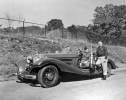Interesting submarine name so I looked it up.....
USS Cero (SS-225), a Gato-class submarine, was the first submarine and second ship of the United States Navy to be named for the cero.
The cero (Scomberomorus regalis), also known as the pintado, kingfish, cero mackerel, cerite or painted mackerel.
USS Cero (SS-225) received seven battle stars for World War II service. Of her eight patrols, all but the second were designated as successful war patrols. She is credited with having sunk a total of 18,159 tons of shipping.















